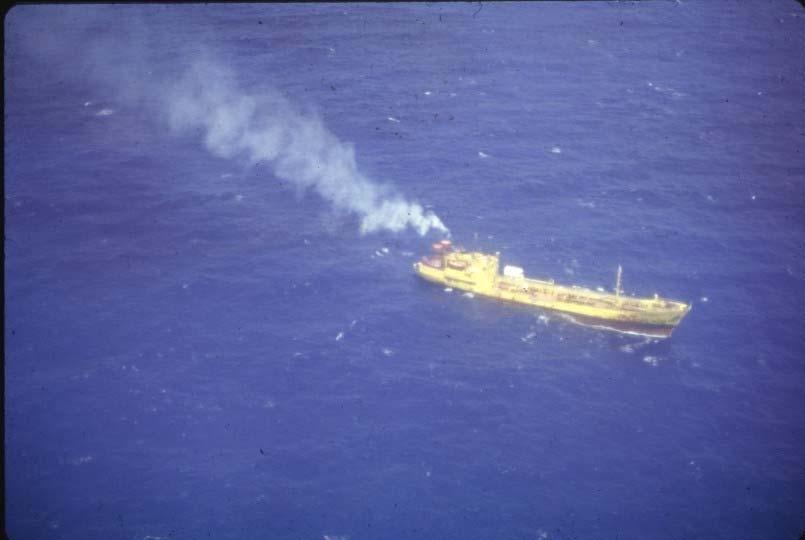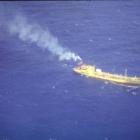After WWII, the petrochemical industry shaped the spaces and habits of people’s everyday life. Plastic materials became unavoidable companions; petrochemical derivatives and synthetic fibers sustained an ever-growing demand for food, medicines, clothes, and comforts; PVC was the fabric of a new modernity. But disposable progress came at a high cost: the generation of millions of tons of hazardous chemical waste.
Ocean incineration, a process that consisted of the thermal destruction of chemical liquid substances in specially designed ships outfitted with high-temperature combustion chambers, promised to solve the age-old problem of hazardous waste disposal. It was deemed innocuous because of the buffering capacity of the oceans; it promised to keep high industrial productivity while minimizing private companies’ externalities; and it happened far from public view. Thus, throughout the 1970s, both in Western Europe and in the United States governments invested steadily to perfect ocean incineration and engaged in multilateral negotiations to regulate it. The practice was commercialized in the early 1980s, but by the end of the decade it was dismissed and in 1997 the International Maritime Organization formally outlawed it.

Vulcanus II: Built in 1982 by the US company Waste Management Inc., it was the largest incinerator vessel in the world. It could burn up to 4430 tons of liquid waste per load.
Vulcanus II: Built in 1982 by the US company Waste Management Inc., it was the largest incinerator vessel in the world. It could burn up to 4430 tons of liquid waste per load.
Photograph by Karl-Heinz Hochhaus, 2016.
Accessed via Wikimedia on 12 May 2021. Click here to view source.
 This work is licensed under a Creative Commons Attribution 3.0 Unported License.
This work is licensed under a Creative Commons Attribution 3.0 Unported License.
My aim here is to sketch out the rise and fall of ocean incineration and investigate the main causes for its decline. My argument is that the demise of ocean incineration was mostly due to a combination of locally-oriented and transnationally-driven protests that emerged across the (North) Atlantic from the early 1980s onward and that successfully exposed the dangerous and highly exploitative nature of such a practice. It was the coalescence of a trans-local movement, one that merged local advocacy with transnational mobilization, that uncovered the environmental risks of ocean incineration and eventually stopped it.
Throughout the 1970s, when ocean incineration was being tested by several Western European countries (off the coasts of the Netherlands, in the North Sea) and by the US (both in the Gulf of Mexico and in the proximity of the Johnston Atoll, in the Pacific Ocean), the main advocates of it were the military elites, who thought of it as the safest way to dispose of outdated chemical arsenals, and the hazardous waste management business, which saw in it the possibility of high yield investments. From the early 1980s onward, however, marine biologists and chemists started warning against the hazards of ocean incineration. Several studies highlighted the lack of adequate monitoring of the emissions, the release of such toxic compounds as dibenzofurans and dioxin, and the contamination of the oceans’ micro-layer, a stratum of nutrient-rich water that supports a wide variety of plant and animal life. The risk was that these emissions could change the chemical structure of the micro-layer, altering water’s alkalinity and the whole ecosystem of a number of oceanic organisms. The so-called “bio-accumulative” effect of sea-incineration thus directly threatened fisheries and the human food chain.

Vulcanus I: The first and oldest incinerator ship of the world, the MT Vulcanus I, was built in 1972 by the Dutch company Ocean Combustion Service. In 1977, the US Air Force employed it to incinerate 2.3 million gallons of Agent Orange at sea.
Vulcanus I: The first and oldest incinerator ship of the world, the MT Vulcanus I, was built in 1972 by the Dutch company Ocean Combustion Service. In 1977, the US Air Force employed it to incinerate 2.3 million gallons of Agent Orange at sea.
Unknown photographer, 1977.
Courtesy of USAF Occupational and Environmental Health Laboratory.
 This work is licensed under a Creative Commons Public Domain Mark 1.0 License.
This work is licensed under a Creative Commons Public Domain Mark 1.0 License.
When these risks became known, on the one hand, the hazardous waste business community backed up a series of studies that portrayed ocean incineration as an environmentally acceptable, safe, and cost-effective method, while on the other those local communities whose lives depended on ocean waters’ quality started condemning ocean incineration as a symbol of industrial exploitation. The most vocal dissenters were middle-class women, the so-called “housewives-turned-activists,” who, as in the case of many other concurrent anti-toxic campaigns, took the lead of the anti-ocean incineration front. These women strategically politicized the natural environment—and water in particular—so to expose ocean incineration’s intergenerational risks and long-term biological hazards. They lobbied local and national authorities and coordinated a wide array of activities. In the US, and in the Gulf region in particular, they established such successful grassroots groups as the Gulf Coast Coalition for Public Health, a volunteer-based organization that represented a multifaceted cross-section of the Rio Grande Valley population and that gave voice to such economically vulnerable citizens as those fishermen and workers of the tourism industry whose subsistence was directly endangered by at-sea incineration.
In 1983–1984, these bottom-up pressures succeeded in temporarily halting ocean incineration. When the US Environmental Protection Agency (EPA) organized one of the first public hearings on the subject, in November 1983, the citizens of Brownsville, a town in the south of Texas, participated en masse. More than six thousand people, including residents of coastal communities, migrant workers, church groups, students, and a plethora of local and state officers, gathered to criticize the EPA’s ocean incineration program, challenging the soundness and reliability of its research, contesting the expansion of the so-called incineration zones, and promoting further studies on the short- and long-term consequences of the offshore burns.
The disturbing images of vessels belching forth great clouds of black stacks in the ocean, however, raised concern not only at the local level. Environmentalist groups and ecologist organizations like Greenpeace, the Cousteau Society, and the Oceanic Society mounted an effective campaign at the transnational level too. These groups kept participating in and affecting the outcomes of the most important multilateral, international discussions on the matter. Through their flagship direct actions, Greenpeace activists made sure that ocean incineration could get sufficient press coverage and public attention. Most importantly, these organizations sponsored a series of independent studies that eventually debunked the myth of ocean incineration’s safety. Thanks to this varied transnational and local activism, a campaign that went under the name of “Ban the Burn,” it was finally possible to prove that ocean incineration magnified the risks of environmental disaster and that its environmental costs largely outweighed its benefits.
How to cite
Fazzi, Dario. “Ban the Burn: The Trans-Local Campaign against Ocean Incineration, 1983–1988.” Environment & Society Portal, Arcadia (Spring 2021), no. 19. Rachel Carson Center for Environment and Society. doi:10.5282/rcc/9311.
ISSN 2199-3408
Environment & Society Portal, Arcadia
 This work is licensed under a Creative Commons Attribution 4.0 International License.
This work is licensed under a Creative Commons Attribution 4.0 International License.
2021 Dario Fazzi
This refers only to the text and does not include any image rights.
Please click on an image to view its individual rights status.
- Borowy, Iris. Defining Sustainable Development for Our Common Future: A History of the World Commission on Environment and Development (Brundtland Commission). London: Routledge, 2014.
- Enders, Danielle. “From Wasteland to Waste Site: The Role of Discourse in Nuclear Power’s Environmental Injustices.” Local Environment 14, no. 10 (2009): 917–937.
- Hamblin, Jacob Darwin. “Gods and Devils in the Details: Marine Pollution, Radioactive Waste, and an Environmental Regime circa 1972.” Diplomatic History 32, no. 4 (2008): 539–560. doi:10.1111/j.1467-7709.2008.00712.x.
- Malin, Stephanie A. The Price of Nuclear Power: Uranium Communities and Environmental Justice. New Brunswick, NJ: Rutgers University Press, 2015.
- Martini, Edwin. A. “‘This is Really Bad Stuff Buried Here’: Agent Orange, Johnston Atoll, and the Rise of Military Environmentalism.” In Proving Grounds: Militarized Landscapes, Weapons Testing, and the Environmental Impact of U.S. Bases, edited by Edwin A. Martini, 111–42. Seattle and London: University of Washington Press, 2015
- Müller, Simone. “‘Cut holes and sink ‘em’: Chemical Weapons Disposal and Cold War History as a History of Risk.” Historical Social Research 41, no. 1 (2016): 263–284. doi:10.12759/hsr.41.2016.1.263-284.
- Parmentier, Rémi. “Greenpeace and the Dumping of Waste at Sea: A Case of Non-State Actors’ Intervention in International Affairs.” International Negotiation 4, no. 3 (1999): 435–457 doi: 10.1163/15718069920848561.








